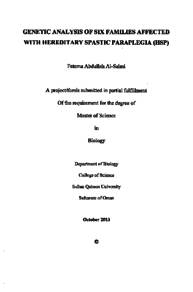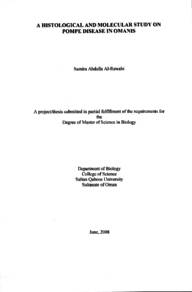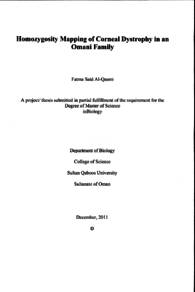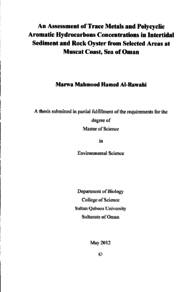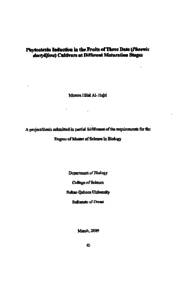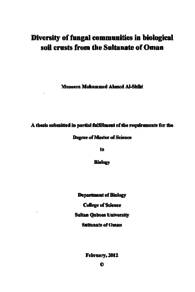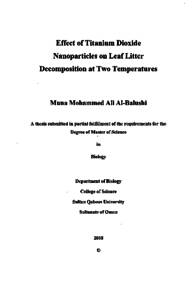Document
Genetic analysis of six families affected with hereditary spastic paraplegia (HSP)
Publisher
Sultan Qaboos University
Gregorian
2013
Language
English
Subject
English abstract
Hereditary spastic paraplegia (HSP) encompasses a heterogeneous and expanding group of neurodegenerative conditions in which the prominent clinical features are progressive spasticity and weakness of lower limbs, which may (complicated HSP) or may not (pure HSP) be associated with additional symptoms. To date more than 50 HSP loci (SPG1-SPG53) have been mapped and 29 genes identified.
This project aim to genetically analyse six families (five Omani and one Turkish) presenting with HSP. Two main approaches were used in this project to identify the causative gene in each family; Homozygosity mapping technique and Exome sequencing. These methodologies led to the identification of 3 novel mutations (not reported before in dbSNP build 131) in 3 different genes in 3 of the families studied. A novel splice-site mutation (c.2351+2 C>A) in amyotrophic lateral sclerosis 2 (ALS2) gene (2933.1) in the Turkish family with four affected siblings was identified. Moreover, another novel mutation was identified in one of the Omani families with one affected child in solute carrier family 22, member 17 (SLC22A17) gene linked to 14q11.2. This missense mutation (c.499 G>A) gives a probability to which SLC22A17 gene would be a potential novel HỢP gene. Additionally, exome sequencing accompanied with homozygosity mapping identified a potential novel HSP gene in a third with three affected siblings. The mutation identified is a missense mutation in ethanolaminephosphotransferase 1
(EPTI) gene linked to 2p23.3. PCR-based direct sequencing of other family members revealed that the mutation c.335G>C in EPT1 gene co-segregates in the family and is absent in 100 Omani control chromosomes. Further analysis is recommended to prove SLC22A17 and EPT1 genes to be novel HSP causing genes added to the 29 genes previously identified. For TecOIIII! the other three families in this study, the causative genes could not be identified. However, direct sequencing excludes the known HSP variants in the coding regions and splice sites for all the known HSP genes in the homozygous regions.
Member of
Resource URL
Arabic abstract
إن الشلل السفلي التشجني الوراثي (HSP) يشمل حالة عصبية متغيرة الخواص وواسعة، التي تظهر فيها الخواص السريرية شلل التشنجي متزايد مع ضعف في الأطراف السفلية، والتي يمكن للحالة العسيرة من المرض منه أن تشمل أعراض اضافية. وحتى اليوم تم تعيين أكثر من 50 حالة من المرض (-SPG1 SPG53) و تحديد 29 من الجينات الوراثية المسببة له. ويهدف هذا المشروع إلى تحليل ستة عوائل تحلية وراثية (خمسة عوائل عمانية و واحدة تركية تعاني من المرض. وقد تم استخدام أسلوبين رئيسيين في المشروع لتحديد الجين المسبب في كل عائلة، تقنية موضعة الزيجوت متماثلة الألائل ( homozygosity mapping ) وعملية تسلسل مناطق الرموز في الجينوم (exome sequencing) . وقادت هذه المنهجية إلى تحديد 3 تغيرات جديدة أو غير مألوفة (لم يتم التقرير عنها سابقة في dbSNP بناء 131 وهي قاعدة بيانات موحدة لتعدد أشكال النوكليوتيدات) وذلك بتحديد 3 جينات مختلفة في 3 من العوائل التي يتم دراستها. وقد تم تحديد موقع طفرة الجيني جديدة ( c . 2351 + 2CA ) في الجين ALS2 بموقع 2q33 . 1 في العائلة التركية مع أربعة أخوة مصابين. إضافة إلى تحديد تغير آخر جديد في إحدى العوائل العمانية والتي تضم طفل واحد مصاب في الجين SLC22A17 المرتبط ب 14q11 . 2 . هذه الطفرة الجينية ( c . 499 G > A ) تعطي احتمالية إلى أن جين SLC22A17 قد يكون جين جديد محتمل لمرض الشلل السفلي التشنجي الوراثي. إضافة فقد ساعد تسلسل الأكسوم يرافقه الزيجوت المتماثل الالائل لاكتشاف وجود جين محتمل جديد للمرض في عائلة ثالثه وذلك مع ثلاثة أخوة مصابين. فقد تم تحديد طفرة جينية في جين EPT1 المرتبط ب .2p23 . 3 ، كما أن تفاعل البلمرة المتسلسل (PCR - المبني على التسلسل المباشر لبقية الأعضاء في العائلة اظهر تواجد التغير 335G > C .ء في جين EPTI عند كل الأعضاء المصابين في العائلة وهو غائب في 100 عينة عمانية من أشخاص أصحاء. نوصي في دراستنا بتحليلات أكثر للإدلال على أن SLC22A17 و EPT1 هي الجينات الجديدة لمرض (HSP) والتي هي الجينات المسببة المضافة إلى 29 جين المحددة مسبقا للمرض. وللعوائل الأخرى الثلاثة المشمولة في هذه الدراسة، الجين المسبب يمكن أن لا نتمكن من تحديده، مع ذلك، التسلسل المباشر يستثني متغيرات الHSP المعروفة في مناطق الترميز ومناطق الترابط لجميع جينت HSP المعروفة في المناطق عمالة الواقع.
Category
Theses and Dissertations

